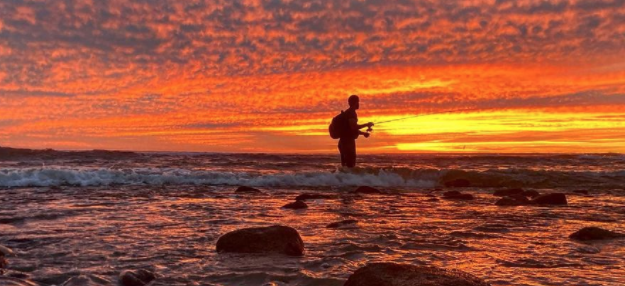BY NICK HEID
Do you check the tides before you fish? If you don’t, you probably should. Tides are arguably the most important set of conditions to pay attention to when planning a surf fishing session. The oth- er main condition set to pay attention to would be surf height, but for now, let’s talk tides.
High tides
Tidal height refers to the average height that the water reaches in ref- erence to sea level. This is an important factor to consider because high tides and low tides vary more than you might think. Did you know that some low tides are higher than some high tides? Weird, right?
A quick tip: Check the tides and know what height your local beach- es can hold before going out. The last thing you want is to get trapped against bluffs or rocks by a quickly rising tide.
You can also expect waves to be a bit bigger with the incoming tide. As a tide builds, the direction of water flow is toward the shoreline. This results in more momentum and therefore, bigger waves on average. Technically this has to do just as much with the height of the tide as it does the tidal phase. That said, on days with rougher surf, it might be a good idea to fish the outgoing to low tide.
Low tides
Low tide can be an extremely valuable tool in surf fishing. Have you ever heard the term “king tide?” A king tide marks the highest tide of the year which comes with the lowest tide of the year. It’s a good idea to use these extreme low tides as opportunities to scout your favorite beaches and look for permanent structure that you can come back to and fish later when the water submerges it properly.
Matching the tides to your fishing spot
Some anglers swear by the theory that fishing the rising tide is al- ways best. I disagree. I think there are certain beaches and more specif- ically, certain spots that are better at higher tides, and certain spots that are better at lower tides.
Where there is good structure with good water coverage within cast- ing range, there will likely be fish. You can find this structure at any beach at any tide, but permanent structure helps here. If you know there’s a series of rocks or other hard structure at a certain beach and those rocks are submerged and in casting range at a certain tidal height, fish it at the optimal tidal height. It’s as simple as that.
Rising tides
So, we know that a rising tide can make the conditions a little harsh- er, but it can also pull fish in closer to the shoreline. When a tide rises, the fish in the water feel this change in the direction of the water. This pulls baitfish in and naturally, bigger fish follow.
Falling tides
A falling tide, although it can help to mellow the conditions, can po- tentially pull fish further out from the shoreline.
At a spot with enough water coverage but relatively close to shore, a falling tide might be sensed by any fish holding in that spot and draw them out deeper. Why? Because they don’t want to risk getting stuck too shallow.
This is especially true of fishing spots with hard structure that causes deep holes but steep changes in terrain. These spots usually have sec- tions that get cut off from the rest of the ocean when the tide gets low enough and most fish don’t like to get stranded in a small pool for birds and humans to prey on them.
Tidal swings
A tidal swing refers to the difference between the high tide and the low tide. The greater the difference, the larger the swing. The idea here is that with a larger swing, there is more water movement. And, with more water movement, there’s more churned-up bait.
The rule I follow: If the water is clean enough, large swings are fan- tastic. If the water is full of weeds and kelp and other conditions make it too tough to control my bait, large tidal swings aren’t great.
These are just a few of the factors to consider with tides, but it’s enough to get you thinking and give you some perspective on why tides matter with surf fishing.




